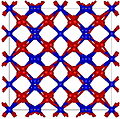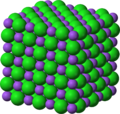Uranium nitrides

| |
| Names | |
|---|---|
| IUPAC name
Uranium nitride
| |
| Identifiers | |
| ChemSpider | |
PubChem CID
|
|
| |
| Properties | |
| U2N3 | |
| Molar mass | 518.078 g/mol |
| Appearance | crystalline solid |
| Density | 11300 kg·m−3, solid |
| Melting point | 900 to 1,100 °C (1,650 to 2,010 °F; 1,170 to 1,370 K) (decomposes to UN) |
| Boiling point | Decomposes |
| 0.08 g/100 ml (20 °C) | |
| Structure | |
| Hexagonal, hP5 | |
| P-3m1, No. 164 | |
Except where otherwise noted, data are given for materials in their standard state (at 25 °C [77 °F], 100 kPa).
| |
Uranium nitrides is any of a family of several ceramic materials: uranium mononitride (UN), uranium sesquinitride (U2N3) and uranium dinitride (UN2). The word nitride refers to the −3 oxidation state of the nitrogen bound to the uranium.
Uranium nitride has been considered as a potential
Synthesis
Carbothermic reduction
The common technique for generating UN is
- 3UO2 + 6C → 2UC + UO2 + 4CO (in argon, > 1450 °C for 10 to 20 hours)
- 4UC + 2UO2 +3N2 → 6UN + 4CO
Sol-gel
Ammonolysis
Another common technique for generating UN2 is the ammonolysis of uranium tetrafluoride. Uranium tetrafluoride is exposed to ammonia gas under high pressure and temperature, which replaces the fluorine with nitrogen and generates hydrogen fluoride.[6] Hydrogen fluoride is a colourless gas at this temperature and mixes with the ammonia gas.
Hydriding-nitriding
An additional method of UN synthesis employs fabrication directly from metallic uranium. By exposing metallic uranium to hydrogen gas at temperatures in excess of 280 °C, UH3 can be formed.[7] Furthermore, since UH3 has a higher specific volume than the metallic phase, hybridation can be used to physically decompose otherwise solid uranium. Following hybridation, UH3 can be exposed to a nitrogen atmosphere at temperatures around 500 °C, thereby forming U2N3. By additional heating to temperatures above 1150 °C, the sesquinitride can then be decomposed to UN.
- 2U + 3H2 → 2UH3
- 2UH3 + 1.5N2 → U2N3
- U2N3 → UN + 0.5N2
Use of the
Decomposition
Each uranium dinitride complex is considered to have three distinct compounds present simultaneously because of decomposing of uranium dinitride (UN2) into uranium sesquinitride (U2N3), and then uranium mononitride (UN). Uranium dinitrides decompose to uranium mononitride by the following sequence of reactions:[9]
- 4UN2 → 2U2N3+ N2
- 2U2N3 → 4UN +N2
Decomposition of UN2 is the most common method for isolating uranium sesquinitride (U2N3).
Uses
Uranium mononitride is being considered as a potential fuel for
Molecular and crystal structure
The uranium dinitride (UN2) compound has a
α-(U2N3) has a
UN has a
The-
Uranium dinitride
-
Uranium sesquinitride
-
Uranium mononitride
Uranium nitrido derivatives
Recently, there have been many developments in the synthesis of complexes with terminal uranium nitride (–U≡N) bonds. In addition to radioactive concerns common to all uranium chemistry, production of uranium nitrido complexes has been slowed by harsh reaction conditions and solubility challenges. Nonetheless, syntheses of such complexes have been reported in the past few years, for example the three shown below among others.[18][19] Other U≡N compounds have also been synthesized or observed with various structural features, such as bridging nitride ligands in di-/polynuclear species, and various oxidation states.[20][21]
 |
 |
 |
See also
- List of energy densities
- Nuclear fuel cycle
- Nuclear reactor
- Uranium carbide
- Uranium oxide
References
- .
- .
- ISSN 0022-3115.
- ^ ISSN 0094-243X.
- ^ Ganguly, C.; Hegde, P. J. Sol-Gel Sci. Technol.. 1997, 9, 285.
- ^ Silva, G. W. C.; Yeamans, C. B.; Ma, L.; Cerefice, G. S.; Czerwinski, K. R.; Sarrelberger, A. P. Chem. Mater.. 2008, 20, 3076.
- ^ urn:nbn:se:kth:diva-35249: Manufacturing methods for (U-Zr)N-fuels
- ^ a b Matthews, R. B.; Chidester, K. M.; Hoth, C. W.; Mason, R. E.; Petty, R. L. Journal of Nuclear Materials. '1988, 151(3), 345.
- ^ PMID 19845318.
- ^ Staff (2009-11-20). "Hyperion launches U2N3-fuelled, Pb-Bi-cooled fast reactor". Nuclear Engineering International. Global Trade Media, a division of Progressive Media Group Ltd.
- ^ "Simple method for producing a stable form of uranium nitride". Advanced Ceramics Report. International Newsletters. August 1, 2012.
[R]esearcher ... Stephen Liddle, says: '... it could help... extract and separate the 2-3% of the highly radioactive material in nuclear waste.'
- ^ Mizutani, A.; Sekimoto, H. Ann. Nucl. Energy. 2005, 25(9), 623–638.
- ^ a b Rundle, R. E.; Baenziger, N. C.; Wilson, A. S.; McDonald, R. A. J. Am. Chem Soc.. 1948, 70, 99.
- ^ a b c Weck P. F., Kim E., Balakrishnan N., Poineau F., Yeamans C. B., and Czerwinski K. R. Chem. Phys. Lett.. 2007, 443, 82.
- ^ a b Wang, X.; Andrews, L.; Vlaisavljevich, B.; Gagliardi, L. Inorganic Chemistry. 2011, 50(8), 3826–3831. doi:10.1021/ic2003244
- ^ Mueller, M. H.; Knott, H. W.Acta Crystallogr.. 1958, 11, 751–752. doi:10.1107/S0365110X58002061
- ^ Évarestov, R. A., Panin, A. I., & Losev, M. V. Journal of Structural Chemistry. 2008, 48, 125–135.
- ^ Nocton, G.; Pécaut, J.; Mazzanti, M. A Nitrido-Centered Uranium Azido Cluster Obtained from a Uranium Azide. Angew. Chem. Int. Ed. 2008, 47 (16), 3040–3042.
External links
- New Uranium Bond at The Periodic Table of Videos(University of Nottingham)



